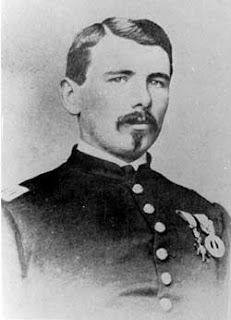On this day in 1876 occurred the Battle of the Little Bighorn, also known as Custer’s Last Stand. Tradition has it that the battle’s sole survivor (at least on the soldiers’ side) was the horse Comanche. Comanche’s owner, Captain Myles Keogh (1840-1876) was an interesting figure in his own right. Born in County Carlow, he seems to have had a craving for adventure from an early age. In 1860, he responded to Pope Pius IX’s call for volunteers to defend the Papal States against the armies of Piedmont-Sardinia. Approximately 1,400 Irishmen responded, and Keogh became a lieutenant in the Irish Battalion. During his time with the Papal Army Keogh was awarded two medals he wore for the rest of his life, the Pro Petri Sede and Ordine di San Gregorio. Soon he left the papal service to fight in the American Civil War. New York’s Archbishop John Hughes recruited papal veterans to fight for the North, and Keogh was among them. In 1862 he was commissioned a captain in the Union Army. Over the next three years he served as a staff officer to several generals, and by the end of the war he had reached the temporary rank (brevet) of lieutenant colonel. Contemporaries described him as “unsurpassed in dash,” “a model… soldier,” and “gallant and efficient.” At the end of the war, Keogh obtained a captain’s commission in the regular army with the famed Seventh Cavalry, where he spent the last ten years of his life. At the Battle of the Little Bighorn, Keogh biographer Brian Pohanka writes that the captain’s body “was stripped but not mutilated, perhaps because of the ‘medicine’ the Indians saw in the Agnus Dei (“Lamb of God”) he wore on a chain about his neck.”












